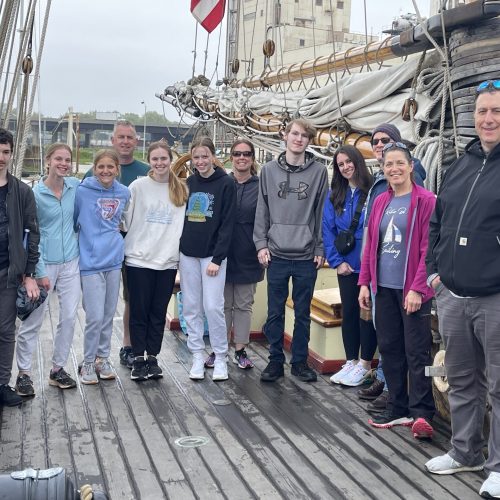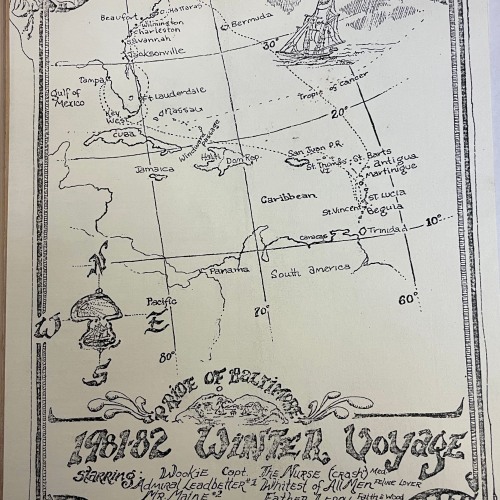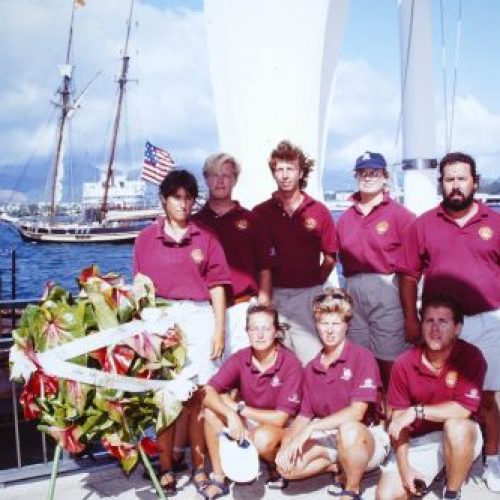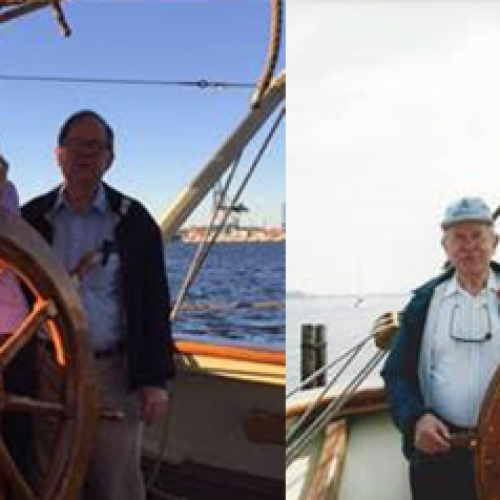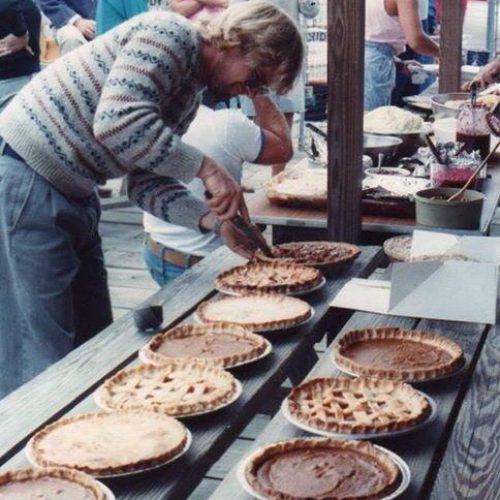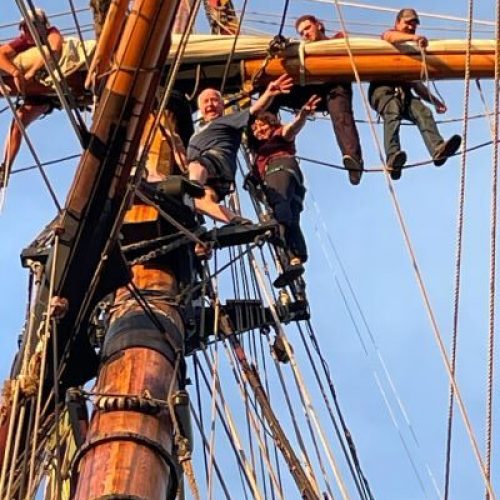DATE : Saturday September 14, 2013
LOCATION : MATANE, QUEBEC, CANADA
PRIDE is anchored awaiting a change in wind direction. We arrived last night at 8 PM in a virtual calm. Not a breath of wind. But the Canadian marine weather forecasters were forecasting northeast winds up to 30 knots starting around midnight. Northeast is the exact direction we need to go for another 200 nautical miles before we turn south around the Gaspe Peninsula. Trying to go against 20-30 knots is not practical at all…so I took advantage of a lee to anchor in at Matane. That harbor has a massive breakwater built out from shore some distance to provide an all weather harbor for a passenger ferry service from the southern shore to the northern shore of the St. Lawrence lower river area.
Going to an anchorage for shelter behind that harbor breakwater from forecast strong winds when there is no actual wind blowing left me with a funny feeling of missing something, considering there was supposed to be some wind from the west going north before the stronger northeast winds. What if the forecasters were wrong? We would lose time and maybe run into another contrary wind situation that might have been avoided had we kept going. No worries however. The first vestiges of the forecast wind arrived with an east-northeast puff of 20 knots around 10 PM. All night long the northeast to east-northeast wind increased slowly to puffs of 30 knots around 6-7 AM. Since 8 AM there has been some moderation to 25 knots.
Overall, a good decision was made by believing the weather forecasters. There were no other locations to take shelter at past Matane. Had we bulled our way past, we would likely have turned around and comeback. So, no fuel was wasted and crew energy was preserved. Not to mention no unnecessary wear and tear to the ship. It looks like we could remain here till tomorrow (Sunday). All depends on what the wind does. There is no shelter from north-northwest-west winds at this anchorage. We would not want to stay anyway with such winds because those winds can be used to proceed on our way toward the northeast.
PRIDE departed her last formal summer of 2013 tall ship festival port of Erie, PA last Monday. Captain Jamie Trost was happy to be relieved of command into the care of his very proud family from Erie, PA. He and the crew did a magnificent job of showing PRIDE at her best during the commemoration of the American’s successful Battle of Lake Erie 200 years ago and then entering the port of Erie in grand style along with the rest of the Tall Ships Fleet for the last port event of the Tall Ships America Great Lakes Tall Ships Challenge port series of 2013. The Trost family was aboard for the Lake Erie Battle commemoration and the sail into Erie so saw firsthand their son’s considerable skill at not only sailing but being a leader to the crew and a knowledgeable spokesperson for Maryland’s World Renowned PRIDE OF BALTIMORE II.
To depart the Great Lakes PRIDE reversed her route into them made last June. First required was the transit from Erie to the Welland Canal across the eastern half of Lake Erie. Some of that transit was under sail, a good training opportunity for half of the crew brand new to the ship as of Erie. Yeah…we lost almost half of this year’s crew all at once in Erie. While we captains try to arrange for the annual August/September period of crew changes to occur in a staggered fashion, this year that did not work out…hence…as we departed Erie we had nearly half new crew aboard. Setting all kinds of sail with a favorable wind was a quick first introduction for all hands to get into the swing of things and still have PRIDE advance without delay on her way toward the Atlantic and destination port of Boston.
The Welland Canal is a lock system PRIDE and I have been through more than a dozen times over more than the last two decades. In fact since 1981 with the first PRIDE and a third schooner of a size between the two PRIDE’s I have been through the Welland Canal 18 times. But now we must carry a pilot due to Canadian Regulation changes that occurred only 2 years ago. The new regulations “capture” smaller vessels than before in an effort to require pilots aboard large uncertified motor yachts. But the new regulations have also captured traditional sailing vessels like PRIDE that are not yachts, but are certified vessels, run by not-for-profit companies, with licensed crews, and a history of numerous safe passages through the Welland without pilots. There is no provision in the regulations to consider types of vessels and services they are providing or their certification or crew credentials. PRIDE has more than a combined 50 feet of overhanging rigging bow & stern that a motoryacht does not have. This makes her exceed the newly established maximum length. If one were to put a motor yacht of PRIDE’s hull length through the Welland, no pilot would be required. But PRIDE requires a pilot. There is no question the extra pilot fees are a significant burden to a not-for-profit.
After a quick late evening transit of the Welland Canal PRIDE cleared into the western end of Lake Ontario and headed eastward for the top of the St. Lawrence River at the far eastern end of Lake Ontario. More sailing was made in Lake Ontario so more crew training was accomplished. Some uncommon training was accomplished as well due to the threat of rain/wind squalls. Sail handling to reduce sail in the dark of night with squalls bearing down added to the list of things PRIDE’s crew must be adept at handling.
The St. Lawrence River is a motoring experience. Fortunately we had the common west-southwest wind coming up from astern so we were able to use the square topsail to help drive PRIDE down the river as it flows toward the northeast. This wind assist, along with the downstream river flow, helps to stretch PRIDE’s fuel range. To assist with this stretching we were also using only one engine. PRIDE can maneuver rather well with only one engine and doing so can increase her fuel range. It is my hope that we can get around Canada without having to stop. Being able to get around without stopping will avoid the time taken to get Customs clearance into and out of whatever Canadian port we go into as well back into the United States. That time saved can be used for other things like sailing.
We had to take another pilot between the American Snell Lock and Montreal Harbor because of the same Canadian regulation changes that were applied to the Welland Canal. PRIDE has made the transit of the “lower” Seaway Locks as many times as she has the Welland Canal. So there is no real need to have a pilot aboard. But there is a total cost of some $18,000 for the services of a pilot aboard PRIDE.
Once clear of the Seaway Lock System and into the free flowing portion of the St. Lawrence River stretching from Montreal to the Atlantic past Quebec City PRIDE made her way without pilot. This is an interesting story as well. From my first trip into the Lakes with the first PRIDE back in 1981 till 1999 there were no pilot requirements between a place called Escoumins, Quebec and Montreal, a distance of some 260 nautical miles. From 1981 to 1999 I took three different vessels of nearly equal size as PRIDE into and out of the Great Lakes eight different years without a pilot. In 1999 the rules changed and we had to have a pilot between Escoumins and Montreal. This year there was a decision made to recognize that sailing vessels like PRIDE did not need to have a pilot between Escoumins and Montreal because the extended rigging beyond the hull was not deemed representative of the actual length of the ship.
There is an overall irony that two different neighboring pilot zones going through changes of policy at the same time result’s in a net transfer of financial burden paid by PRIDE from one association to the other as a result of reversed philosophies. Notwithstanding the above irony all our pilots but one or two over the years were great individuals and consummate professionals. They did not know much about a sailing ship but they learned that the crew of PRIDE were serious and professional. I can recall some great conversations with pilots about their country and about their business. And while it is true that a pilot aboard can assume the navigation of PRIDE, they cannot assume the actual ship handling. A pilot assuming the navigation…or properly speaking…the piloting of the vessel…leaves the master free to relax a small bit. It is also nice knowing that missing a navigation mark or colliding with another vessel is unlikely and that all vessel traffic service communications by radio will be handled with efficiency. One of the minor downsides of a pilot aboard is the reduced experiences being accumulated by the watch leaders.
Well, here we are at anchor at Matane awaiting a favorable weather change on day six of a fifteen day transit to Boston. We have traveled 719 nautical miles so far and we have used 420 gallons of fuel out of a total of 870 gallons. We have 906 nautical miles to go. If we are able to depart tomorrow, we will have 9 days to make the distance. Normally for such a distance we would have 8 days. Unlike these last 719 miles the next 906 miles requires negotiating the prevailing westerlies that flow from Boston toward the east along the southern side Nova Scotia. If that contrary flow is in full force when we get to Cape Canso at the east end of Nova Scotia we will be forced to wait again for a different more usable wind pattern for the run westward along Nova Scotia and on to Boston. At least there are more open water areas ahead than the tight rivers and canals we have been through thus far. Such openness could provide more than one way to use a given breeze to the good of getting along our way.
Meanwhile as we lay at anchor the crew are getting various maintenance chores and safety check items done. So, no vessel care time goes to waste, tied to the dock, underway or at anchor.
Signed,
Jan C. Miles
And the weather bound crew of PRIDE OF BALTIMORE II

